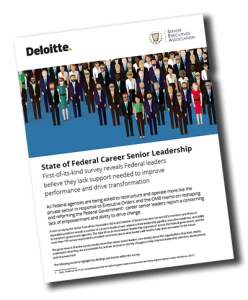 Transforming the Senior Executive Service
Transforming the Senior Executive Service
On March 20, 2018, we published an article entitled SES Jobs – Why the SES might be a Good Career Option in 2018. We suggested that candidates for SES positions in the federal government should be up for a challenge and we summarized the kinds of changes that are being discussed to modernize the service. This article is a follow-up that looks at the career challenge for SES execs from a slightly different angle, specifically the new administration’s directive to reshape the Federal government and the capabilities that will be needed to accomplish that goal.
Making Government Run Like a Business
On April 12, 2017, Office of Management and Budget (OMB) director Mick Mulvaney issued Executive Order M-17-22, the Comprehensive Plan for Reforming the Federal Government and Reducing the Federal Civilian Workforce. To date, the Trump administration has been short on specific guidance for change within the SES, but the Executive Order is resoundingly clear about reforms envisioned for the federal government. The directive provides broad instructions for agencies to streamline government operations, eliminate overlapping programs, cut out outdated rules and processes, and reduce the size of the federal workforce. In short, the vision is for a federal government that runs like a lean business enterprise.
The comprehensive plan sets general objectives:
 “Cross-cutting” Reforms – improved interaction and efficiencies across agencies and divisions
“Cross-cutting” Reforms – improved interaction and efficiencies across agencies and divisions- Elimination of silos and duplicate missions
- Cost/benefits analysis and cuts to non-essential activities
- Devolution of agency functions to state, local, and tribal governments where cost and efficiency improvements can be achieved.1
The Executive Order is long on goals and short on specifics. Theoretically, the details and actual implementation would be the responsibility of the senior federal agency executives, but the very inefficiencies and weaknesses that are targeted by the administration’s directive may make it difficult for the current SES leadership to create change from within. Further, there are indications that current SES executives don’t feel that they are up to the challenge.
The SES Needs Transformational Leaders
In October 2017, the Senior Executives Association (SEA) teamed with Deloitte to conduct a survey of over 750 senior federal government leaders.2 In a press release announcing the survey report, Bill Valdez, the SEA President, is quoted:
Federal leaders are being asked to change the way they think and operate to drive transformation in their individual agencies. While the survey results show how deeply career senior leaders care about their organizations, many leaders do not feel empowered with the right tools and support to make these changes a reality.3
The SEA/Deloitte report examines the current senior executive structure in terms of the leadership pipeline, executive readiness, and transformational leadership – assessing the preparedness of leadership to make the kinds of changes envisioned in the administration’s executive order.
The survey responses indicate structural weaknesses:
 Hiring and keeping top candidates is difficult – only 22% of respondents agree that their agency is prepared to retain top talent. There is concern that functional capabilities are overvalued in the selection process – 57% believe that leadership capabilities are adequately weighted as a selection factor.
Hiring and keeping top candidates is difficult – only 22% of respondents agree that their agency is prepared to retain top talent. There is concern that functional capabilities are overvalued in the selection process – 57% believe that leadership capabilities are adequately weighted as a selection factor.- Improvements are needed to develop the next generation of leadership – Only 25% feel that their agency identifies critical skills gaps among the leadership group. 26% feel that there is available infrastructure to support leader development. Only 44% think that there is a strategy to develop future senior leadership.
- Agencies are not adequately prepared for the future of work – 54% of respondents think that leaders lack necessary digital skills. 50% of senior leaders don’t think their agency is considering future workforce trends
- Agency barriers and silos prevent “cross-cutting.” – Only 28% of respondents believe that systems are in place to enable knowledge-sharing across agencies and divisions.
The SEA/Deloitte recommendations are cautious. Framed as an “action step checklist” for agencies and individual leaders, the report’s recommendations reiterate difficulties as much as they suggest specific solutions. The unstated inference is that the solution is the challenge – there is a need to develop transformational leadership that can implement change within the SES and the federal government.
Are You Prepared to be a Transformational SES Exec?
There is general agreement between the administration and the Senior Executive Service on the need for structural change in the way the federal government functions, but ultimately someone will have to develop the specifics. With 65% of SES execs eligible for retirement, it’s likely that a new generation of leadership will be required to modernize and reshape operations within and across government agencies.
Are you up for the challenge? SES positions are open, but the application process is intense. If you’re targeting a Senior Executive Service position, CareerPro Global’s federal career coaching services can help. We work with applicants to edit and refine their ECQs for SES applications and to develop Senior Executive Service Resumes.
If you’re a transformational leader who is ready to make an impact in the SES, we hope you’ll get in touch. There’s no cost for the initial consultation. We’ll be glad to discuss the qualification criteria and how we can help you through the process.
Sources:
1 Memorandum M-17-22, Memorandum for Heads of Executive Departments and Agencies, Office of Management and Budget, 4/12/17.
2 State of Federal Career Senior Leadership, Deloitte Development, LLC / Senior Executive Association, 2017.
3 Press Release: Senior Executives Association, Deloitte Survey, Senior Executives Association, 10/4/17.
 Transforming the Senior Executive Service
Transforming the Senior Executive Service “Cross-cutting” Reforms – improved interaction and efficiencies across agencies and divisions
“Cross-cutting” Reforms – improved interaction and efficiencies across agencies and divisions Hiring and keeping top candidates is difficult – only 22% of respondents agree that their agency is prepared to retain top talent. There is concern that functional capabilities are overvalued in the selection process – 57% believe that leadership capabilities are adequately weighted as a selection factor.
Hiring and keeping top candidates is difficult – only 22% of respondents agree that their agency is prepared to retain top talent. There is concern that functional capabilities are overvalued in the selection process – 57% believe that leadership capabilities are adequately weighted as a selection factor.